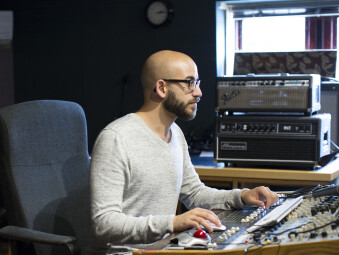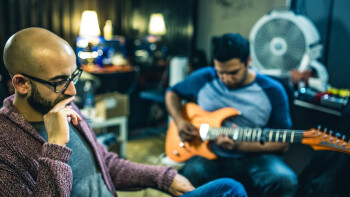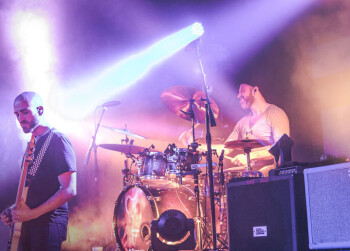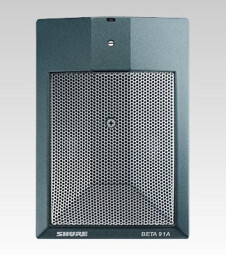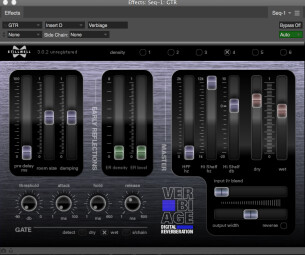Adam “Nolly” Getgood is more than just the bass player in the progressive metal band Periphery. He's also a producer and engineer with an extremely intelligent approach to recording, and he played a major role in the production of the band’s two most recent albums.
Not bad for somebody who only got into recording seven years ago. Based in the U.K., he got started with production through his own demos. Since then, his knowledge and studio skills have grown astronomically. “Once I get into something I want to achieve a really decent level at it. I’m not satisfied to suck at something, ” he says. “Here I am seven years later, having moved into the more professional domain, recording full productions for bands and doing a lot of remote mixing work. I would say that’s a large part of what I do these days, actually mixing for clients on the other side of the world and kind of interacting via email or Skype to mix their records.”
On August 26 abd 27, Nolly and the band’s drummer Matt Halpern will be giving a free online seminar for Creative Live that will go into detail about their production methods, and will include a live demonstration of recording Halpern’s drums.
Audiofanzine had a chance to speak to Getgood recently about recording and mixing techniques and plenty more.
What kind of a system do you work on?
It’s kind of interesting. In this day in age, I’m a firm believer that plug-ins and software have really gotten to a point where — I’m not saying they’re indistinguishable from hardware — but I certainly think you have all the tools to be able to create really great sounding productions without using any hardware. Being a touring musician, a lot of the time I’m actually mixing just on my MacBook Pro, with nothing apart from my iLok and a pair of headphones. Not even using an external headphone amplifier, or anything like that. And I know that’s a huge no-no in the world of audio, but I’ve developed techniques that allow me to really see as well as hear what’s going on, especially at the extremities of low and high end, with the use of frequency analyzers. I’m not reliant upon them, but using them as a guide to be sure that what I’m doing is going to translate on an actual speaker system. [At home] I have just a few choice pieces of hardware — EQs and compressors — and most of the time I use them on the way in. My mixing style is so dependent around plug-ins currently, that I very rarely run things out [of the box] during mixing.
Which DAW do you use?
I’m a Logic user. I’m using Logic Pro X. I passable with Pro Tools, a little more clicking and a lot less shortcuts. Again, I’m definitely not someone who looks down upon someone who uses other DAWs. Logic just happened to be the logical step for me, if you excuse the pun. When I got my first MacBook Pro, I messed with GarageBand, but wanted more control and to be able to use third-party plug-ins, and at that time it wasn’t possible. Logic Express was the next step for that. Once you start to learn a program, I think it makes sense just to stick with it. And now with the updates they’ve applied to FlexTime and some of the new folder systems they have in Logic Pro X, I think there’s very little you need to go elsewhere for. I’m very content using Logic.
Do you mainly use it on your laptop, or do you also have it on a desktop system, as well?
I have it on an iMac system here at home. And that’s obviously my preference, to be at home. I have a very nicely treated mix room with some very nice Adam monitors in it, that a miss a lot when I’m not at home.
I was intrigued by you saying that you mix on headphones a lot. Do you actually finish mixes that were strictly done on headphones?
I have done that. Yeah. I definitely started and worked on the complete process without doing anything but referencing on speaker systems. Not ones that I know, but if we’re on tour and there’s an ability to plug something into some kind of system obviously, at that point, I’m so used to the headphones that I’m trusting them, always more.
You mentioned that using spectrum analyzers is part of the process when you’re using headphones. Is it also part of your process when you’re mixing on monitors?
Honestly, it’s part of my mixing process in general. It’s not reliant [on the spectrum analyzers], but they’re a quick way of getting things into the right ballpark. The big thing for me is getting the low end right, which is of course, very difficult on headphones…
It’s difficult on speakers.
Yeah. Of course. It’s the most difficult part, I think. And getting raw tracks to an appropriate level of brightness. And that’s always something that I struggled with when I was trying to find my mixing voice. Raw tracks are never as bright as commercial tracks. If you’ve got a raw drum kit, it doesn’t matter what microphone you used, or if you used a $5,000 snare drum. Even the best sounding snare drum in the world is always going to come through sounding dull when you compare it to some kind of professional production. That initial change that goes on when you first pull up the session, and you’re listening to those tracks in their raw state, your ear quickly acclimatizes to that. I always find I start making boosts in the high end because obviously I could tell that it was little bit dull, but I would always be overly cautious about it, because your ears are just acclimatized to this darker, warmer sound.
That’s an interesting point.
You could leave it up to the mastering engineer to apply that brightness later on. But what I find very helpful is two things: One is using frequency analyzers to quickly see how much high content there is. The other is applying broad shelving EQs to maybe busses, or individual instruments, to get them appropriately bright, so that your ear gets acclimatized to that, and you use that as the reference point. I’m really talking about broad paintbrush strokes, before your ear gets used to these duller sounding tracks, and kind of working within the confines of that — your ear is getting acclimatized with something that’s far more in the right ball park for the end result. Also, I always mix into a certain amount of high-shelving boost and low shelving boost, as well. And that’s something that really changed the game for me, again. Getting everything to a brighter point, a more vivid point, like a commercial record sound, before you even start processing individual tracks.
And this is on the master bus?
Yeah. I might use a typical 12kHz high shelf, fairly smooth. It could be [boosting] quite a lot, as much as 5dB. A smooth slope. I might also have a wide bell coming in around 5kHz. And that’s generally my starting point. And then something that’s bringing up some low end around 100 Hz, and maybe high-passing with a resonant high-pass [filter] kind of beefing up the sub lows. What I really finds that helps with is phase coherence between tracks. On my drum tracks, if I’m boosting up high end on every track individually and I’m juggling low end content between several kick drum microphones, I’ll inevitably run into all sorts of phase cancellations that are occurring when you combine those signals together. However, when you combine them before that, they’re all being treated together, you’re not actually going to have so many discrepancies in phase between the tracks. It’s a subtle difference, but I really find that helps with not having issues, especially with drums, because you have so many microphones picking up so much bleed with the whole kit.
Do you have particular subgroups that you typically treat?
The EQ that I was talking about, really lives on the master bus. But when it comes to the drum kit, I’ve made a real point in the last couple of years to try and achieve maximum power and consistency from a purely drum recording. I’m working in the world of rock and metal where it’s become very common to 100-percent replace maybe a kick track with a sample, or maybe a multisample so it still sounds realistic. For me, a huge part of what I’ve been doing the last couple of years, and what I’ve been working with Matt, and what I wanted to go into in the Creative Live class, is how to achieve the level of consistency and power that people are used to achieving with samples — with natural drums. So, that’s a really huge topic for me.
Talk about mixing drums.
My drum setup for a mix will start with soloing — I might use three or four kick drum mics — I might use less, but if I have plenty of inputs during recording I will maybe go through a boundary mic on the kick. I’ll have another kick drum “in” microphone with more midrange content. I’ll have some kind of kick “out” microphone that gives me the whole picture of the drum. That might be enough. I may also have a subkick thrown in there. It really just depends on how I’m feeling that day [laughs] or what the studio has or the time constraints. My first step will be to balance those faders and get something that’s representative of the kick drum sound. I’m not going and EQing my kick “out” mic separately to my kick “in, ” I’m really just trying to get one balanced kick drum sound. And then I’ll send that to a bus, and that’s just my kick bus. I probably won’t revisit those faders again. I’ll just EQ and compress and gate. Whatever processes I’m going to do happen on the bus, which is the combined kick signal. It’s not too dissimilar to what you might do on a console, if you’re summing things down onto single faders just to preserve track, if you’re working in the analog domain.
How are you using the boundary mic in that kick-recording scenario you described?
By boundary mic I’m actually referring to two different ones: It would either be the Shure Beta 91 or the original SM91 or the Sennheiser e902. Those are kind of intended for use with kick drums. They’re omnidirectional condenser microphones that you just sit inside of the drum. You generally have a pillow or some other muffling in the drum, and it can just sit right in there. Being a condenser, it picks up a very immediate attack, a very, very sharp sound, which is perfect for the kind of thing I do.
It seems like in modern metal, the kicks have more high-end content, and are drier and not as boomy as they were in older metal recordings. Would you say that’s correct?
|
Nolly likes using a Shure Beta-91 boundary mic inside the kick drum in a multi-mic kick setup
|
Absolutely. With rock and metal there’s always a balance to be found between the kind of envelope at the front end of the shell attack — we’re talking about kick or snare or tom — and the EQ. I think those two things work in tandem. Sometimes, I think a common mistake that people make, I’ve certainly made it in the past, is to rely too much on boosting up the high end on a kick drum or snare drum, where actually simply adjusting the envelope a little bit by use of a compressor, and really knowing how to use the attack and release settings to exaggerate the front end snap of that instrument. Maybe you don’t need to use so much high end because that smack is going to push it right to the front of the mix.
Would you ever use a transient processor for that?
I have done that, but I don’t tend to like the sound of them too much. I might use one if the drummer isn’t hitting particularly hard.
How many mics do you usually use when you mic Matt’s kit?
For Matt’s kit, I would say probably 16 at the minimum.
How do you avoid phase problems with so many mics?
Mic choice, mic placement and being very fastidious during tracking. And prioritizing things to an extent. If I know that the spot mic on the splash cymbal is just going to be there to support the splashes, then maybe I will chop out the signal entirely when the splash isn’t being hit. I don’t need to worry so much about if the snare is coming through in phase. If it is, then that’s great. But if the snare level is coming through so weakly in something that’s going to be quite in the mix, then the amount of cancellation is really going to be quite minimal. I am very, very fastidious about snare-to-overhead and toms-to-overhead phase relationships. Sometimes a hi-hat mic can end up kind of loud in the mix, and that can really ruin a snare sound.
Do you observe the “3-to-1 Rule” to avoid phase problems? [The 3-to-1 rule says you should keep mics that are capturing the same source three times the distance from each other than they are from the source.]
The thing with the 3-to-1 rule is, it’s a good rule, but it only really makes sense if the source is equally loud in both microphones, and those microphones are then mixed equally loud after the fact. Because as soon as you start adjusting the ratio you’re not going to get the 100 percent cancellation. Obviously, it’s going to eek into the signal, but I find that if I really want to get good isolation, I’m reaching for a hypercardioid microphone or even a figure-8 microphone. For example, a ride cymbal sometimes can take a more modern ribbon mic, and you can use the null of the pattern, figure-8 pattern to null the crash cymbal that’s next to the ride. Maybe even point the top of the mic down to the snare so that it’s even nulling some of the snare as well. I almost always use a hypercardioid mic on the snare [to minimize bleed]. Usually a Shure Beta-57.
When you’re mixing drums, do you gate them to get rid of the bleed, or are you one of those people that likes bleed?
That’s a really tough topic. And that’s one of things where I feel my approach has been able to achieve such powerful, sort of “sample-esque” drum sounds without using samples. One of the really big things that I got into is to use a multiband compressor plug-in that allows me to turn one of the bands into an expander. Particularly I like the Fab Filter Pro MB, which is so adaptable. What I’ve been doing is just turning on the high band, and setting that to 2 or 3 kHz, so it’s shelving everything above that, and using it as an expander that’s essentially gating only high frequencies when the signal doesn’t cross the threshold. This is so useful on the snare drum in particular. And I apply this just to the snare top microphone. The bottom one doesn’t really need it, it’s not getting much cymbal bleed.
So how does this processing help you with bleed?
I’m cutting a huge amount of top end out of that signal when the snare isn’t physically being hit. Instead of gating the whole signal, it’s actually just reducing the level of cymbals in the bleed. In the overall mix the bleed is drastically minimized, but you’re not gating the drum, you’re not taking all of the life out of it. You’re not also hearing those cymbals firing back for a second every time you hear the drum being struck. Now it’s all symbiotic, you have to have nailed everything through the engineering stage, the production stage, to get that completely seamless. But if you get it right it’s very satisfying. Sometimes I’ll follow that with a gate, maybe not gating, but expanding, even just 6 or 7 dB, and you listen to the close mic it doesn’t sound like a lot, but in the context of the mix you’re turning down the cymbal bleed by 6 or 7 dB, that’s a big difference.
How do you usually place the overhead mic pair?
I love a good overhead sound, and I’ve experimented with all the different overhead placements, and I’ve found a really good way of doing a spaced pair, where I almost always measure four feet from the center of the snare drum. Generally, four feet out to each microphone. I’m not afraid for them to look a little bit unbalanced vertically. Generally, the hi-hat side one is going to be a little bit higher, because typically, drummers’ drum kits are kind of one sided. I try to minimize that, I don’t mind if the right side one is kind of over the shells and the hi-hat side one is almost over the floor a little bit, capturing the outer edge of the cymbals. That gives me a really good balance of the kit, which sounds like I’m really looking down into the center to the snare and the cymbals are super wide around the edge, which is that modern sound that people are after.
And where do you generally place your room mics?
It really depends on the room, but I like to have something fairly close, and that’s more just tying the kit together. I’m actually a fan of stereo, I know a lot of people like mono crush mics — some people call them trash mics — sometimes I’ll use those. But generally, I like to have things in pairs. If I’m close up to a kit what I really like is a stereo microphone. My favorite thing for that is probably a stereo ribbon microphone, and my favorite of those would be an AEA R88, which I’ve just had the pleasure of using on a few recordings. You put that maybe 4 or 5 feet in front of the kit. And being a ribbon microphone, it’s figure-8. And you’ve got two figure-8 microphones at 90 degrees, so you’re getting 360 degrees around, and you get a lovely representation of the kit, with all the panning correct. You can hear the toms pan across, all the cymbals pinpoint, it’s almost like a pair of overheads. But through the rear lobe you’re getting back the lovely ambience of the room. Just by experimenting with pushing forwards toward the kit or back into the room, you can find a lovely balance there. And the added transient information you’re getting from being close to the kit means that when you compress it, that there’s more transient information for the compressor to work on and make it really big, without just kind of mashing a transient-weak signal, which tends to really bring out the cymbals. And then I always, if I can, like to have a further away pair. Typically against the back wall of the studio. Or, more often then not, out in a hallway.
Do you use a lot of reverb on the drums?
I think if I took the reverb that I normally use, which is actually a free-trial plug-in made by Stillwell Audio called Verbiage. It’s an emulation of a digital reverb, it’s not a space reverb. I almost treat that like I have a hardware Lexicon sitting in a rack. Whenever I open a new session template it’s down a send ready to go. I almost always use that on drums. It’s such a familiar sound for me. And you don’t perceive it as reverb. I never have it so isolated in the mix that it sounds like a reverb. What I really find it does, when I put it on the snare drum, is that it blends the snare drum into the room mic. Just kind of provides that ramp down into the natural room mics that are occurring behind it. I don’t know how to describe that better than that, but for some reason that plug-in does that better than anything else.
And it’s typically the snare you use it on?
Snare and toms.
How big of a room do you have dialed up on the reverb?
It’s not so big, typically about 1.5 seconds. It’s decent. You hear it. But what it does really well is to spread the snare sideways after it hits.
Talk about some of the plug-ins that you like to use.
I’m a big fan of the Slate Digital Plug-ins. I’m really big into the VMR, and the buss compressors that they make, and the tape and console emulation are really handy for me, especially if I’m doing everything in the box, I like to treat my busses almost like I’m using a summing mixer, even if it’s just all within the program. I’ll use instances of those console emulations and tape emulations, not to add saturation, but to give you that glue of a console.
Others?
I’m very into the Fab Filter plug-ins. I think I mentioned the multiband earlier. But the gate, the EQ — Pro Q 2 is my go-to for anything where I really need to do surgical EQ. It’s just my workhorse EQ through and through. And that’s obviously a very different style of plug-in to the Slate stuff. Generally I group my plug-ins into those that are very futuristic and that only do what a digital plug in can do, or those that are analog emulations. I tried to find the one of those that has the most pleasing sound for me.
Any others?
My favorite plug-ins I’ve found recently are the Kush Audio ones. The Electra DSP EQ is so good that I went and bought the hardware one for tracking through. It’s very intuitive to use. It’s great, because there are so few numbers on it. When you’re in the box it’s very easy to get over analytical with that stuff. And the UVK-1, it’s a really fun compressor, saturator thing that I love using on trash mics, or for effect on certain sections. I know I can find something unique and musical on that.
|
Listen to Nolly’s Production Work
Here are some links to videos featuring music produced in full or part by Adam “Nolly” Getgood. https://www.youtube.com/watch?v=f_cOlUKIYy0 https://www.youtube.com/watch?v=XCPVX1V0GO4 |

